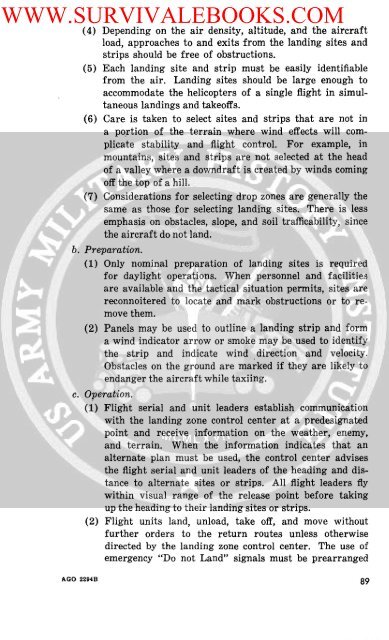FM 57-35 Airmobile Operations - Survival Books
FM 57-35 Airmobile Operations - Survival Books
FM 57-35 Airmobile Operations - Survival Books
- No tags were found...
You also want an ePaper? Increase the reach of your titles
YUMPU automatically turns print PDFs into web optimized ePapers that Google loves.
WWW.SURVIVALEBOOKS.COM(4) Depending on the air density, altitude, and the aircraftload, approaches to and exits from the landing sites andstrips should be free of obstructions.(5) Each landing site and strip must be easily identifiablefrom the air. Landing sites should be large enough toaccommodate the helicopters of a single flight in simultaneous landings and takeoffs.(6) Care is taken to select sites and strips that are not ina portion of the terrain where wind effects will complicate stability and flight control. For example, inmountains, sites and strips are not selected at the headof a valley where a downdraft is created by winds comingoff the top of a hill.(7) Considerations for selecting drop zones are generally thesame as those for selecting landing sites. There is lessemphasis on obstacles, slope, and soil trafficability, sincethe aircraft do not land.b. Preparation.(1) Only nominal preparation of landing sites is requiredfor daylight operations. When personnel and facilitiesare available and the tactical situation permits, sites arereconnoitered to locate and mark obstructions or to remove them.(2) Panels may be used to outline a landing strip and forma wind indicator arrow or smoke may be used to identifythe strip and indicate wind direction and velocity.Obstacles on the ground are marked if they are likely toendanger the aircraft while taxiing.c. Operation.(1) Flight serial and unit leaders establish communicationwith the landing zone control center at a predesignatedpoint and receive information on the weather, enemy,and terrain. When the information indicates that analternate plan must be used, the control center advisesthe flight serial and unit leaders of the heading and distance to alternate sites or strips. All flight leaders flywithin visual range of the release point before takingup the heading to their landing sites or strips.(2) Flight units land, unload, take off, and move withoutfurther orders to the return routes unless otherwisedirected by the landing zone control center. The use ofemergency "Do not Land" signals must be prearrangedAGO 2294B89
















